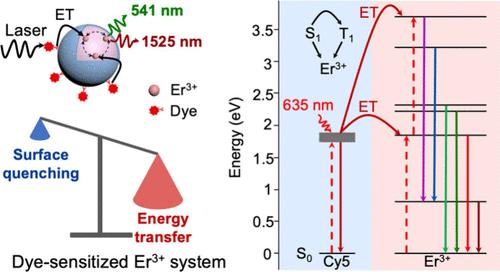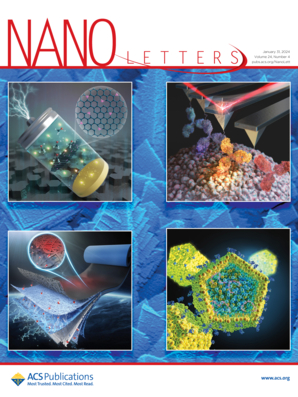Dye-to-Er3+ Direct Energy Transfer for Enhancing Up- and Down-conversion Luminescence in Sub-10 nm NaErF4
IF 9.6
1区 材料科学
Q1 CHEMISTRY, MULTIDISCIPLINARY
引用次数: 0
Abstract
Dye sensitization enhances the luminescence of lanthanide nanoparticles by improving light-harvesting. Typically, Yb3+ serves as an energy bridge but absorbs at a single transition, limiting dyes’ options (λex > 700 nm) due to the spectral overlap requirement. In contrast, the emitter Er3+ spans energy levels from UV to NIR, making it ideal for multicolor excitation. We developed a strategy to directly sensitize Er3+ upconversion (UCL) and downconversion luminescence (DCL) by using cyanine dyes. Cy5 demonstrated the greatest enhancement, achieving a 1942-fold UCL and 70-fold DCL increase compared to nanoparticles alone (Er-NPs) under 980 nm excitation. Smaller Er-NPs exhibited brighter dye-sensitized luminescence due to enhanced interfacial energy transfer. A 2 nm inert shell produced the brightest UCL, while thicker shells improved DCL. Dye-sensitized Er3+ emissions at 2H11/2 (525 nm) and 2P3/2 (408 nm) enabled temperature monitoring with a maximum sensitivity (Sa) of 3.69%/K. This approach holds significant potential for optical temperature sensing and medical imaging.

染料-Er3+ 直接能量转移用于增强 10 纳米以下 NaErF4 的上转换和下转换发光能力
染料敏化可通过改善光收集来增强镧系元素纳米粒子的发光效果。通常情况下,Yb3+ 可作为能量桥,但只在一个转变中吸收,由于光谱重叠的要求,染料的选择受到限制(λex > 700 nm)。相比之下,发射体 Er3+ 的能级跨度从紫外到近红外,因此非常适合多色激发。我们开发了一种使用氰基染料直接敏化 Er3+ 上转换发光(UCL)和下转换发光(DCL)的策略。与单独的纳米粒子(Er-NPs)相比,在 980 纳米激发下,Cy5 的增强效果最好,UCL 和 DCL 分别提高了 1942 倍和 70 倍。由于界面能量传递增强,较小的 Er-NPs 表现出更亮的染料敏化发光。2 nm 的惰性外壳能产生最亮的 UCL,而较厚的外壳则能改善 DCL。在 2H11/2 (525 nm) 和 2P3/2 (408 nm) 处的染料敏化 Er3+ 发射实现了温度监测,最大灵敏度 (Sa) 为 3.69%/K。这种方法在光学温度传感和医学成像方面具有巨大潜力。
本文章由计算机程序翻译,如有差异,请以英文原文为准。
求助全文
约1分钟内获得全文
求助全文
来源期刊

Nano Letters
工程技术-材料科学:综合
CiteScore
16.80
自引率
2.80%
发文量
1182
审稿时长
1.4 months
期刊介绍:
Nano Letters serves as a dynamic platform for promptly disseminating original results in fundamental, applied, and emerging research across all facets of nanoscience and nanotechnology. A pivotal criterion for inclusion within Nano Letters is the convergence of at least two different areas or disciplines, ensuring a rich interdisciplinary scope. The journal is dedicated to fostering exploration in diverse areas, including:
- Experimental and theoretical findings on physical, chemical, and biological phenomena at the nanoscale
- Synthesis, characterization, and processing of organic, inorganic, polymer, and hybrid nanomaterials through physical, chemical, and biological methodologies
- Modeling and simulation of synthetic, assembly, and interaction processes
- Realization of integrated nanostructures and nano-engineered devices exhibiting advanced performance
- Applications of nanoscale materials in living and environmental systems
Nano Letters is committed to advancing and showcasing groundbreaking research that intersects various domains, fostering innovation and collaboration in the ever-evolving field of nanoscience and nanotechnology.
 求助内容:
求助内容: 应助结果提醒方式:
应助结果提醒方式:


